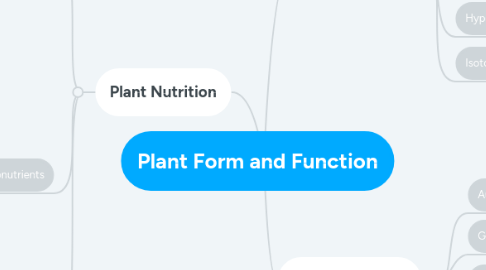
1. Plant Nutrition
1.1. Micronutrients
1.1.1. Boron
1.1.1.1. For Cell wall synthesis
1.1.2. Chlorine
1.1.2.1. Water splitting system for photosystem II
1.1.3. Copper
1.1.3.1. Co-factors for metalloprotiens and enzymes
1.1.4. Iron
1.1.4.1. Regulatory component for proteins and metabolites in roots and leaves
1.1.5. Manganese
1.1.5.1. Photodestruction of chlorophyll and chloroplasts structure
1.1.6. Molybdenum
1.1.6.1. For enzyme activation
1.1.7. Zinc
1.1.7.1. Enzymatic function and reactivity
1.2. Macronutrients
1.2.1. Nitrogen
1.2.1.1. For chlorophyll synthesis
1.2.2. Phosphorus
1.2.2.1. For energy transferring processes
1.2.3. Potassium
1.2.3.1. Cell extension and stomatal regulations
1.2.4. Calcium
1.2.4.1. Structural component of cell wall and membrane
1.2.5. Magnesium
1.2.5.1. Chlorophyll Synthesis
1.2.6. Sulfur
1.2.6.1. Assimilation of Oxidation
1.3. Major Constituents of Organic Plant Material
1.3.1. Carbon
1.3.2. Hydrogen
1.3.3. Oxygen
2. Plant growth
2.1. Osmosis
2.1.1. Net movement of water
2.2. Tonicity
2.2.1. Movement of water inside and outside the cell
2.3. Hypotonic
2.3.1. Movement of water towards the cell; more solute, less water
2.4. Hypertonic
2.4.1. Movement of water away from the cell: less solute, more water
2.5. Isotonic Solution
2.5.1. No net movement, equal solute and water
3. Plant Hormones
3.1. Auxin
3.1.1. stem elongation, cell growth and expantion
3.2. Gibberellin
3.2.1. promotes stem elongation and germination
3.3. Cytokinin
3.3.1. cell division, growth of fruits, and delays aging
3.4. Ethylene
3.4.1. ripening of crops
3.5. Abscisic Acid
3.5.1. Seed dormancy and control loss of water
